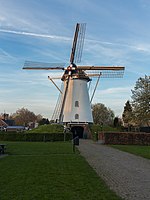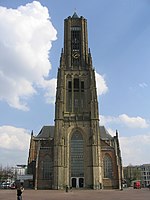GelreDome

The GelreDome (Dutch pronunciation: [ˈɣɛlrəˌdoːm]) is a retractable roof football stadium in the city of Arnhem, Netherlands. Built from 1996 to 1998 at a cost equivalent to €75 million, that opened on 25 March 1998. The stadium has been the home of association football club Vitesse Arnhem since 1998. It was one of the stadiums used during Euro 2000 tournament held in the Netherlands and Belgium. Both international and Dutch artists have given concerts in the stadium, including Lady Gaga, Shakira, Pearl Jam, Bruce Springsteen, Tina Turner, Celine Dion, Madonna, Prince, Spice Girls, Justin Bieber, Paul McCartney, Shakira, Iron Maiden, AC/DC, André Rieu, The Rolling Stones, Justin Timberlake and Rihanna. The stadium has a retractable roof, as well as a convertible pitch, that can be retracted, when unused during concerts or other events held at the stadium, and a climate control system. It has a capacity of 34,000 people for sports events, or 41,000 during concerts. The GelreDome pitch is surrounded on each side by four covered all-seater stands, officially known as the Edward Sturing Stand (North), Charly Bosveld Stand (East), Theo Bos Stand (South) and Just Göbel Stand (West). The GelreDome currently holds a four-star rating by UEFA.
Excerpt from the Wikipedia article GelreDome (License: CC BY-SA 3.0, Authors, Images).GelreDome
Elzenlaan, Arnhem
Geographical coordinates (GPS) Address Website External links Nearby Places Show on map
Geographical coordinates (GPS)
| Latitude | Longitude |
|---|---|
| N 51.962777777778 ° | E 5.8927777777778 ° |
Address
GelreDome
Elzenlaan
6831 GM Arnhem
Gelderland, Netherlands
Open on Google Maps









